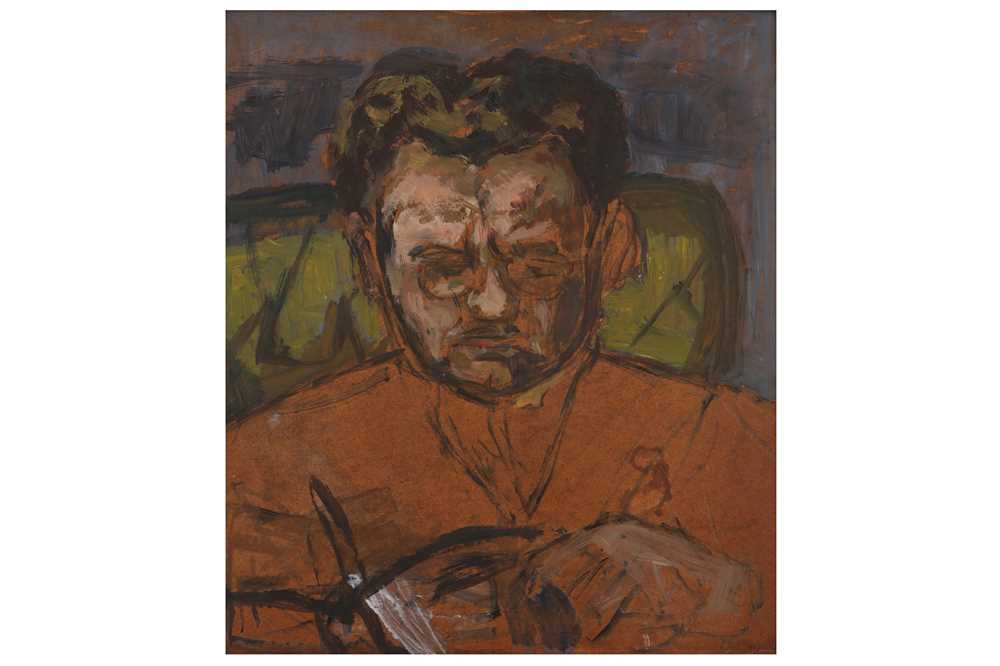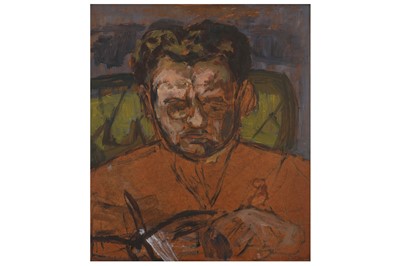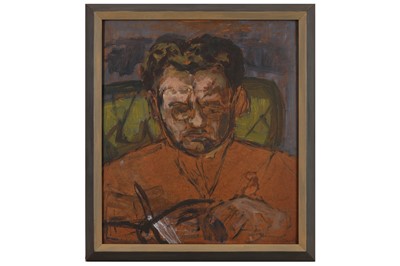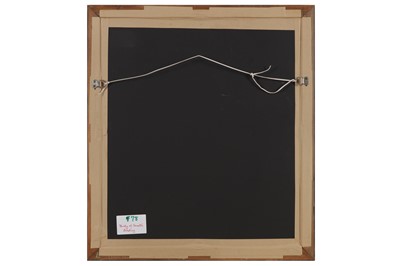4th Dec, 2020 14:00
British & European Fine Art | Live Online
MARIE-LOUISE VON MOTESICZKY (AUSTRIAN 1906 - 1996)
Property from the Marie-Louise von Motesiczky Charitable Trust
MARIE-LOUISE VON MOTESICZKY (AUSTRIAN 1906 - 1996)
Study of Canetti Reading
oil on board
60.8 x 53.2 cm (24 x 21 in)
LITERATURE:
Kristian Wachinger (editor), Elias Canette. Bilder aus seinem Leben, Munich, 2005, p. 94, illustrated
Ines Schlenker, Marie-Louise von Motesiczky 1906-1996, A Catalogue Raisonné of the Paintings, New York, 2009, p. 182, no. 78, illustrated
Ines Schlenker and Kristian Wachinger (editors), Liebhaber ohne Adresse. Briefwechsel 1942-1992, Munich, 2011
Painted circa 1945, the present work is Marie-Louise's earliest likeness of Elias Canetti (1905-1994), the Nobel prize-winning author. Born in Bulgaria, Canetti had emigrated from Vienna to England with his wife Veza in 1939, and like Marie-Louise spent the war years in Amersham, north west of London. There Marie-Louise and he began a relationship that would last the next three decades. As a man who professed the need to maintain relationships with different women simultaneously, Canetti was by turns supportive and manipulative of Marie-Louise as a person, but never wavered in his belief in her artistic abilities. As late as 1978 he wrote to Marie-Louise: ‘You are a great painter and whether you want it or not, the world will hear of you. Every picture that you paint will enter the history of art.’
Marie-Louise described Canetti as one of her 'chief gods' (the other two being Max Beckmann and her mother), and she both treasured and endured Canetti’s complex personality, accommodating many of his demands. Among these was the housing of a considerable portion of his library in the house in Amersham, and later in Hampstead, where she kept a room for him to work in. Canetti himself was not an easy sitter, but Marie-Louise featured Canetti in two other notable portraits, one painted in 1960 now in the Wien Museum, Vienna, the other painted in 1992 which she presented to the National Portrait Gallery, London (Schlenker nos. 165 & 315). Canetti was awarded the Nobel Prize in Literature in 1981.
Property from the Marie-Louise von Motesiczky Charitable Trust (lots 820 - 827)
Viennese emigré artist Marie-Louise von Motesiczky (1906-1996) parted with few of her works during her lifetime, and since her death less than a handful have appeared on the open market. Lots 820 - 827 span four decades - from 1945 to the early 1980s - and mark the first time a group of her paintings is to be offered at auction.
Marie-Louise lived in Vienna until the Anschluss in 1938, when Austria was annexed by Germany and she and her Jewish mother were forced to emigrate to England in 1939. The primary influence on her art was the German painter Max Beckmann whom Marie-Louise had first met in her early ‘teens in 1920. She recalled: ‘A winged creature from Mars could not have made a greater impact on me’.
During her formative years Marie-Louise enjoyed a privileged life. Her mother Henriette was scion of an illustrious Viennese Jewish banking dynasty. Her maternal grandfather, Leopold von Lieben, was President of the Stock Exchange; her grandmother, Anna, one of Freud’s early patients. She counted the Todescos, and Ephrussis among her family circle. Growing up in an apartment on Brahmsplatz in central Vienna, she, her mother and her brother Karl spent their summers at Villa Todesco in Hinterbrühl, south west of the capital.
But over time family tragedy, financial difficulties and the rise of Nazi Germany took their toll. Marie-Louise’s father had died in a hunting accident many years before and her mother’s considerable inheritance gradually diminished through high taxation, poor investments, and the financial crash of 1929. Then, with the rise of the Third Reich she and her mother felt compelled to flee Austria. Further distress followed when her brother Karl, who had remained in Austria, was arrested and deported to Auschwitz, dying of typhus there on 25 June 1943.
Immediately following the Anschluss Marie-Louise and her mother travelled to Holland, emigrating to Britain early the following year. In London she reconnected with Oskar Kokoschka, a family friend in Vienna but now similarly exiled. Kokoschka ensured that her work was shown in a series of group exhibitions, culminating in a one-person exhibition at the Czechoslovak Institute in the autumn of 1944.
Despite Kokoschka’s support, starting afresh in Britain proved challenging, and it wasn’t until 1960 that she had her next one-person show at the influential Beaux Arts Gallery. But on the Continent Marie-Louise’s reputation was growing. She received wide acclaim when her work was exhibited in Amsterdam and The Hague in 1952, one of her canvases being purchased by the Stedelijk Museum; she showed in Munich in 1954 and Düsseldorf in 1955, and in the 1960s enjoyed further shows in Austria and Germany. Finally, a full 25 years on, in 1985 her work was shown again in London, at the Goethe-Institut. Widely acclaimed in the press, it seemed the climate was favourable for the re-discovery of Marie-Louise’s art.
Further exposure followed: In 1994 she was the subject of a major retrospective in Vienna at the Osterreichische Galerie, Oberes Belvedere and in Manchester at the City Art Gallery. In 2006-07 her work was shown in a centenary exhibition at Tate Liverpool, and travelled to Frankfurt, Vienna and Passau, ending in Southampton City Art Gallery. In 2007 Jill Lloyd’s biography of Marie-Louise appeared, followed in 2009 by the catalogue raisonné of her paintings by Ines Schlenker. Most recently, in the autumn of 2019, Tate Britain held an exhibition devoted to her to inaugurate the gallery named in perpetuity as the ‘Marie-Louise von Motesiczky Archive Gallery’ for all future displays of Tate’s archive holdings in general.
The work of Marie-Louise von Motesiczky held in public collections
Institutions in the UK holding works by the artist include: the British Museum, Freud Museum, National Portrait Gallery and Tate in London (which also holds her archive); the Fitzwilliam Museum, Cambridge, New Walk Museum and Art Gallery, Leicester, Manchester Art Gallery, National Galleries of Scotland, Edinburgh and the Hunterian Art Gallery, Glasgow. Elsewhere her work is in the National Gallery of Ireland, Dublin; the Stedelijk, Amsterdam; the Boijmans van Beuningen Museum, Rotterdam; the Städel Museum, Frankfurt; the German Literary Archive in Marbach; the Albertina, Österreichische Galerie Belvedere, the Leopold Museum and the Museum Wien in Vienna, and the Lentos Kunstmuseum. Linz.
The Marie-Louise von Motesiczky Charitable Trust
The Marie-Louise von Motesiczky Charitable Trust, is a company limited by guarantee registered in England and Wales (no. 7572024) and a registered charity (no. 1140890): www.motesiczky.org. The copyright for Marie-Louise von Motesiczky’s paintings, drawings and sketches lies with the Marie-Louise von Motesiczky Charitable Trust.
Sold for £6,250
Includes Buyer's Premium
Do you have an item similar to the item above? If so please click the link below to submit a free online valuation request through our website.



